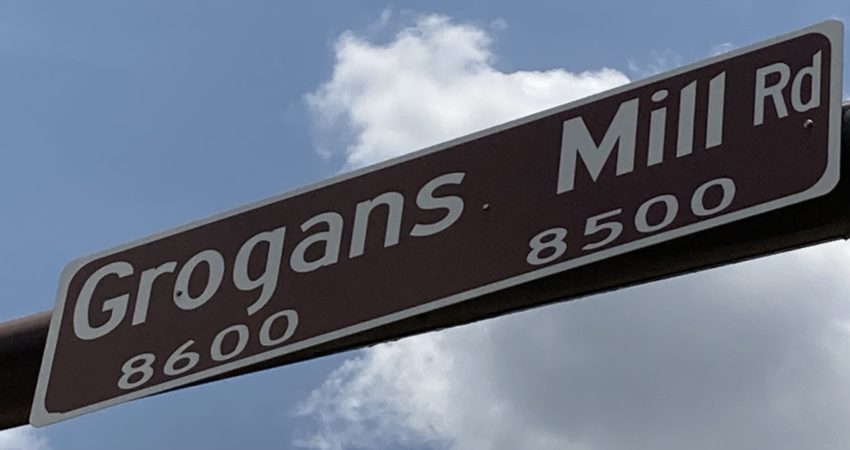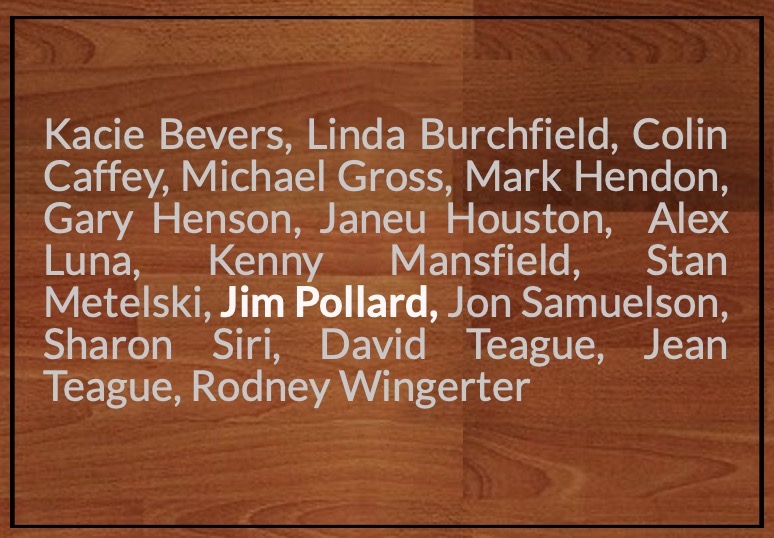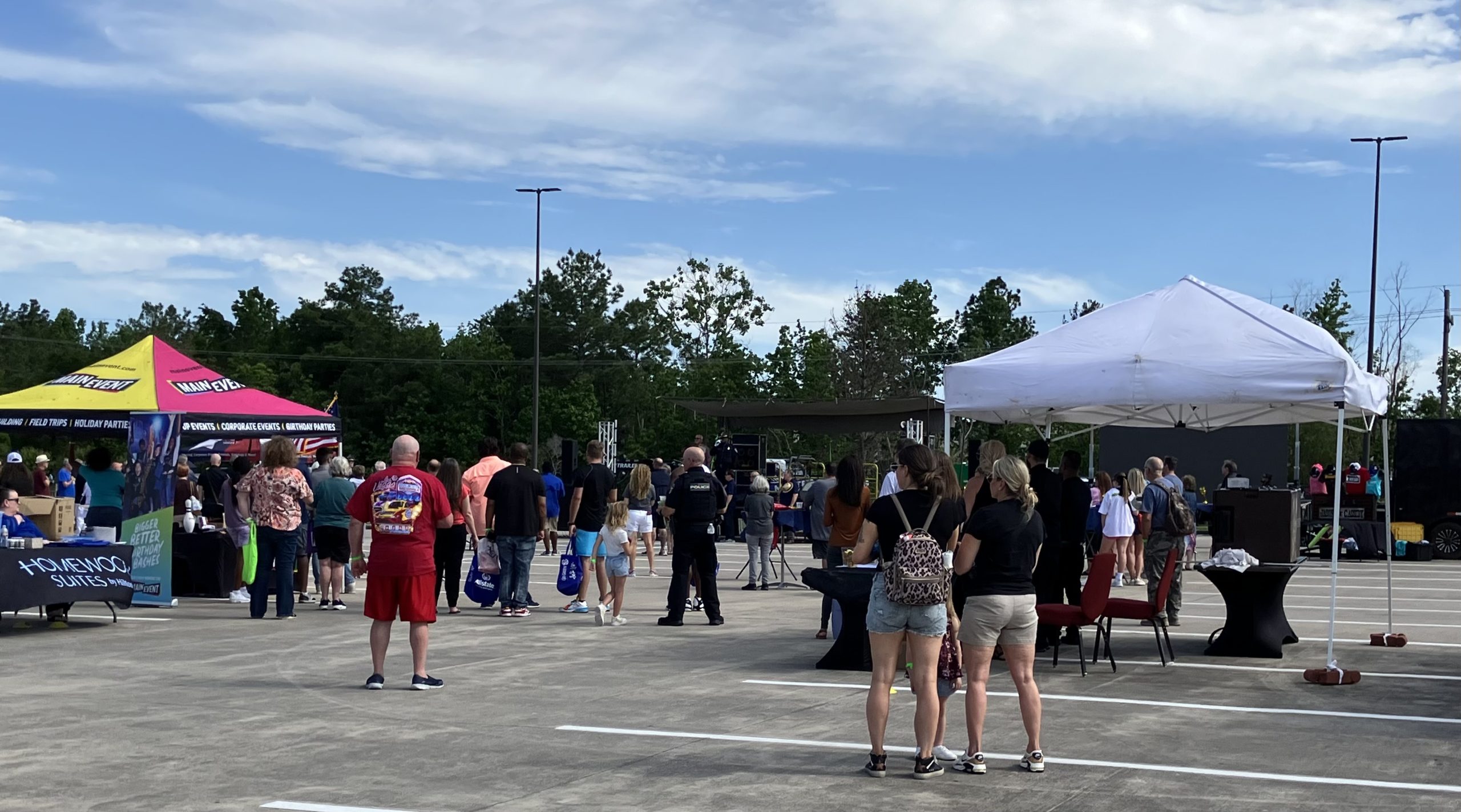After a decade of intense controversy over how to improve the intersections at Grogan’s Mill and Research Forest, Montgomery County is scheduled to begin construction improvement projects this summer, according to Precinct 2 officials. The first phase includes extending the acceleration lane on Research Forest (see diagram below). The next phase, after utility lines are relocated, will add a dedicated right turn lane from Research Forest to Grogan’s Mill northbound.
Due to rising safety concerns and attempts to better regulate traffic flow several years ago, local officials commissioned traffic studies which proposed drastic elevation changes — an overpass or underpass. Residents in both Shenandoah and The Woodlands neighborhoods had instead insisted on at-grade solutions. An “at-grade” solution indicates all construction is at street level. At the February 23, 2022 Shenandoah city council meeting, Montgomery County Precinct 2 Commissioner Charlie Riley and engineer John Bleyl presented traffic solutions for the intersections. Riley stated, “We’re going to get something on the ground now.”
The graphic below illustrates the two phases of at-grade solutions proposed (anticipated start date Summer 2022).

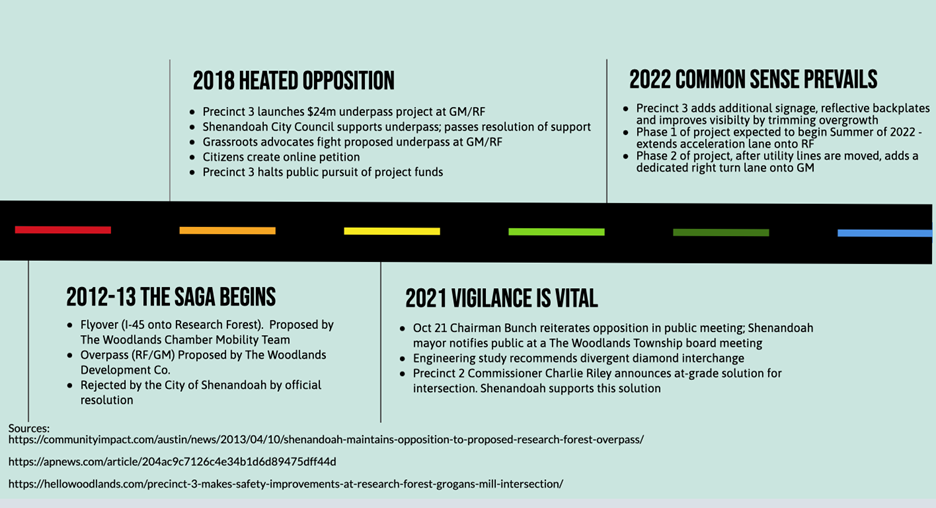
History
These intersections have a long history of proposed changes dating back to 2012 when an overpass was proposed at Research Forest and Grogan’s Mill in conjunction with a flyover at I-45 and Research Forest. The entirety of the flyover and a portion of the overpass was designed within Shenandoah city limits. Initial support for these projects was initiated by The Woodlands Chamber of Commerce Mobility Committee with sponsor funding from Woodlands Road Utility District (WRUD). Greg Smith, Shenandoah city administrator at the time, was quoted by the Houston Chronicle as stating, “We have not been consulted, we have not been given any plans, we haven’t seen any studies.” Smith indicated that the city became aware only after a resolution was passed at a Woodlands Chamber of Commerce meeting.
In response, Shenandoah City Council promptly passed a resolution in August 2012 opposing the flyover and overpass at Grogan’s Mill and Research Forest. This essentially blocked the project from receiving federal funding through Houston-Galveston Area Council (H-GAC). In 2013, Precinct 3 requested reconsideration of the city’s opposition. In that same year, the city council voted (4-1) not to reconsider their opposition to the flyover/overpass.
In 2015, Precinct 3 commissioned a mobility study facilitated by H-GAC that included representatives from the city of Shenandoah, city of Oak Ridge North, The Woodlands Township and Montgomery County. The study was expansive in scope yet not exhaustive in detail. H-GAC’s involvement is significant due to their allocation of federal funds for local mobility projects. (See H-GAC traffic survey.) While this study now recommended an underpass at Research Forest and Grogan’s Mill ($14 million estimated cost), engineering data supported higher priorities at other locations in the study area. Further, at-grade improvements listed in the study, costing approximately $3 million dollars, were not considered as viable options by political agencies.
In 2018, the County Commissioner for Precinct 3 began to execute plans for an underpass at Research Forest under Grogan’s Mill. Similar to circumstances in 2012, residents discovered the intentions of public officials only after Shenandoah city council unanimously passed a new resolution in support of an underpass on May 23, 2018. This new resolution supporting the underpass raised the ire of residents in both Shenandoah and The Woodlands, especially since the resolution was not accompanied by studies or designs. While Mayor Wheeler did discuss details of an underpass during the April 11, 2018 meeting, discussion occurred during council inquiry with no notice provided to the public via the meeting’s agenda.
Even after a Shenandoah town hall in early September 2018, residents’ anger only increased when the estimated cost of the project eventually ballooned from $14 million to $24 million. Substantial resident concerns included increased traffic, seemingly illogical traffic patterns (outdated and inconsistent data), clear cutting of trees, flooding, reduced property values, and noise. Importantly, bottlenecks at I-45 and Research Forest (east) and traffic signals west of the intersections would still cause significant flow delays even with an underpass. Ultimately, residents could not reconcile the cost of millions of tax-payer dollars for nominal traffic benefit. The Woodlands Villager recorded the unvarnished sentiment of Woodlands resident, Larry Toepper: “spending $24 million of tax-payer funds to fix a delay of 65 to 80 seconds at the traffic lights at Research Forest and Grogan’s Mill was a ‘ridiculous amount of money to spend.’”
Residents organized grassroots efforts to stop the underpass by attending governmental meetings, including those at Commissioners Court, The Woodlands Township, Shenandoah, The Woodlands Road Utility District (WRUD) and H-GAC. They also initiated an online petition that garnered hundreds of signatures of citizens opposed to the underpass. Residents met personally with elected officials. The massive citizen outcry prompted The Woodlands Township Chairman Gordy Bunch to host a town hall meeting where he invited representatives from the Howard Hughes Corporation. In spite of efforts by Precinct 3 and Howard Hughes Corporation to drive the project forward, Precinct 2 Commissioner Riley attended the town hall and spoke on behalf of concerned citizens. Ultimately, Precinct 3 did not apply for H-GAC funding during that cycle.
In 2019, a new traffic study by Strand Associates was commissioned by officials from both Precincts 2 and 3. After collecting new data, the Strand study had multiple designs but recommended a diverging diamond interchange (see diagram below). Conversations included leadership from Shenandoah and The Woodlands. Chairman Gordy Bunch placed the item on the October 21, 2021 Township Board Meeting agenda to ensure public awareness of the new study. When vigilant residents analyzed the study results, The Woodlands residents again joined their Shenandoah neighbors and actively fought to end efforts to urbanize these intersections.
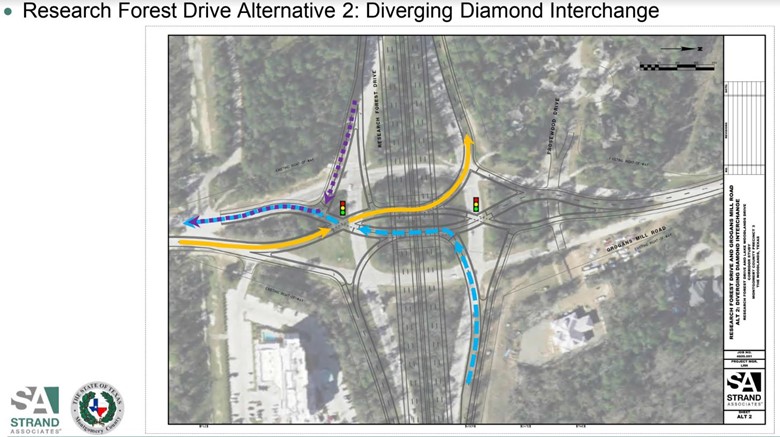
On March 9, 2022 Shenandoah passed a resolution requested by residents which contains specific language opposing elevated construction while supporting at-grade solutions. Responding to his constituents, Commissioner Riley independently commissioned engineer John Bleyl to research and design an at-grade solution. Commissioner Noack made improvements such as placing reflective backplates on traffic signals, increasing signage with solar powered “wrong way” signs and removing overgrowth to improve visibility. Precinct jurisdiction over the intersections is split between Riley and Noack, with Riley over the north side of Research Forest and Noack over the south side.

